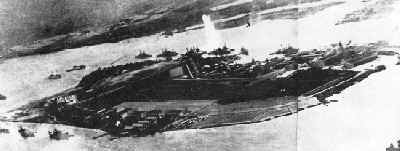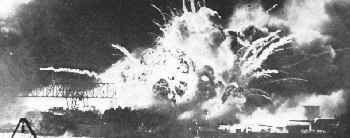The attack by the Japanese on Pearl Harbor, Hawaii, took place on December 7th 1941. The attack on Pearl Harbor was called a “day of infamy” by President FD Roosevelt. It was to bring the United States of America into World War Two.
|
The attack as photographed from a Japanese plane |
The air attack was led by Commander Mitsuo Fuchida. The first wave of planes consisted of 183 fighters, bombers and torpedo bombers. It started its attack at 07.55 a.m. The second wave had 170 planes in it and attacked Pearl Harbor at 08.54 a.m.
They took off from the aircraft carriers Akaga, Kaga, Hiryu, Soryu, Zuikaku and Shokaku. By the time the war ended, all six had been sunk by the Americans along with all the other Japanese capital ships involved in the attack.
The pilots in the first attack used a radio station’s mast near Pearl Harbor to home in on. The first casualties were 35 American servicemen who were having breakfast at the Army Air Forces’ Hickam Field – a 550lb bomb hit their dining hall.
The most serious casualty was the USS Arizona. One torpedo and eight bombs hit her, 1,760 lbs. of explosives, as she lay moored up at Ford Island Naval Station. One bomb is thought to have pierced the forward deck setting off over one million pounds of gunpowder. 1,177 men were killed on the Arizona alone.
Those who survived on the USS Nevada – moored directly behind the Arizona and badly damaged in the attack – claimed that the Arizona was launched up to ten feet into the air as a result of the huge explosion that tore her apart and sunk within nine minutes. One witness on the Nevada said that the Arizona was broken in two before she sunk. Along with the Arizona, the Utah and the Oklahoma never sailed again but all the other ships damaged in the attack did sail again once repairs had been successfully carried out.
|
USS Shaw exploding during the attack |
Twenty-nine Japanese planes were brought down by the defences at Pearl Harbor during the attack that lasted for two hours. Midget submarines were also used in the attack and one managed to get into Pearl Harbor itself – only to be sunk by USS Monaghan.
Ships damaged or lost at Pearl Harbor
|
USS Detroit |
Slight damage |
|
USS Raleigh |
Heavy damage |
|
USS Utah |
Capsized |
|
USS Tangier |
Slight damage |
|
USS Medusa |
Slight damage |
|
USS Curtis |
Moderate damage |
|
USS Nevada |
Heavy damage |
|
USS Arizona |
Sunk |
|
USS Vestal |
Heavy damage |
|
USS West Virginia |
Sunk |
|
USS Oklahoma |
Capsized |
|
USS California |
Sunk |
|
USS Oglala |
Sunk |
|
USS Pennsylvania |
Heavy damage |
|
USS Downes |
Heavy damage |
|
USS Shaw |
Heavy damage |
|
USS Cassin |
Heavy damage |
|
USS Maryland |
Slight damage |
|
USS Tennessee |
Heavy damage |
|
USS Helena |
Heavy damage |
Total American casualties: 2,395 deaths including 54 civilians
Why was Pearl Harbor attacked?
The Japanese saw the base as the pinnacle of America’s military supremacy in the Pacific Ocean. If a catastrophic blow could be struck against America at Pearl Harbor, then the Japanese surmised that America would pull out of the region leaving it free for the Japanese to continue their expansion in the Far East.
The Americans saw Pearl Harbor as impenetrable. The naval station could only be approached by narrow waterways that were only 40 feet in depth, twisting and fully protected by anti-submarine nets. Such was the confidence of the naval command at Pearl Harbor, that the Pacific Fleet was lined up in what was known as “Battleship Row”. This was to prove disastrous when a fleet of planes attacked the base as the pilots would have seen rows of warships in a line and would have only needed to have flown in a straight line over these lines to deliver their deadly payload.
Who was to blame for the disaster?
The bulk of the Japanese fleet had to sail over 4000 miles to get from its base to where the aircraft carriers could launch their planes for Hawaii. Some have criticised the lack of success of America’s intelligence community for failing to notice a complete fleet heading across the Pacific for such a large journey. Others argue that the Japanese left in the dead of night thus not attracting any attention and that they maintained complete radio silence during the journey so any form of radio interception was impossible.
After the attack, recriminations started. Admiral Husband Kimmel (the naval commander at Pearl Harbor) and General Walter Short (head of the army at Pearl Harbor) were held responsible by the American government for not taking the necessary precautions despite the worsening diplomatic relations between Japan and America. Both were demoted and both were denied the right to a court martial where they would have been given the opportunity to defend themselves. Both men died dishonoured in the eyes of America’s military.
However, in recent years there has been a re-consideration about the roles played by Kimmel and Short. America’s Congress has decided to re-instate the ranks of both men before they were demoted. This has to be ratified by the president as commander-in-chief of America’s armed forces and Clinton failed to do this. The onus is now on the current president, George W Bush, to do so.
Some issues have developed since the investigation into responsibility, that have given some historians the opportunity to argue that the event was manipulated by the American government to ‘persuade’ an isolationist public into supporting a desire to get involved in a war assisting the Allies in Europe. These include:
The issue of intelligence gathering. How could a fleet of 30 capital ships spend 11 days at sea travelling 4000 miles without being detected? American seaplane patrols that had taken place each day up to December 6th were stopped the day of the attack. Why? Why were the reports from the captain of the USS Ford ignored? He reported at 3.a.m. and 5 a.m. that the sea around Oahu (the island in Hawaii where Pearl Harbor is stationed) “is full of Japanese submarines”. On both occasions he got the reply “Reinvestigate and report”. One crew member of the ‘Tangiers’ also reported that the chain that was always put across the mouth at the entrance to Pearl Harbor at night for added security against a sea borne attack, was not secured on the night of December 6th. Why was a radar operator told “not to worry” when he reported that something “completely out of the ordinary” was on his screen? The official finding for this was that the response came because it was believed that what the operator saw was a fleet of incoming B17’s expected at the base that day. In fact, he had seen the incoming Japanese planes. Why was a message from General Marshall which stated that Japan had issued “what amounts to an ultimatum” not sent as a matter of urgency to Kimmel and Short? This would possibly have allowed both men to put the base on a state of alert. It arrived by motorbike courier after the attack.
None of the above prove anything and they could be mere coincidences. However, the attack on Pearl Harbor did lead to America getting involved in the Second World War. Joseph Goebbels, the Nazi Propaganda Minister, wrote on December 9th in his diary “Japan has suddenly taken action…….the mood among the German people has risen considerably.”
President Roosevelt said of the attack that “it was a date which will live in infamy” and “no matter how long it may take for us to overcome this premeditated invasion, the American people in their righteous might will win through to absolute victory.”

